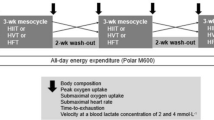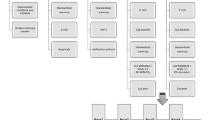Abstract
The main purpose of the present study was to examine the effects of acute whole body vibration (WBV) on recovery following a 3 km time trial (3 km TT) and high-intensity interval training (HIIT) (8 × 400 m). Post-HIIT measures included 3 km time-trial performance, exercise metabolism and markers of muscle damage (creatine kinase, CK) and inflammation (c-reactive protein, CRP). A second purpose was to determine the effects of a 3 km TT and HIIT on performance and metabolism the following day. Nine well-trained, middle-aged, male runners [(mean ± SD) age 45 ± 6 years, body mass 75 ± 7 kg, \( \dot{V} \)O2peak 58 ± 5 ml kg−1 min−1] performed a constant pace run at 60 and 80% velocity at \( \dot{V} \)O2peak (v \( \dot{V} \)O2peak) followed by a 3-km TT and a 8 × 400-m HIIT session on two occasions. Following one occasion, the athletes performed 2 × 15 min of low frequency (12 Hz) WBV, whilst the other occasion was a non-WBV control. Twenty-four hours after each HIIT session (day 2) participants performed the constant pace run (60 and 80% v \( \dot{V} \)O2peak) and 3 km TT again. There was a significant decrease in 3 km TT performance (~10 s) 24 h after the HIIT session (P < 0.05); however, there were no differences between conditions (control vs. vibration, P > 0.05). Creatine kinase was significantly elevated on day 2, though there were no differences between conditions (P > 0.05). \( \dot{V} \)O2 and blood lactate were lower on day 2 (P < 0.05), again with no differences between conditions (P > 0.05). These results show no benefit of WBV on running performance recovery following a HIIT session. However, we have shown that there may be acute alterations in metabolism 24 h following such a running session in well-trained, middle-aged runners.





Similar content being viewed by others
References
Bakhtiary AH, Safavi-Farokhi Z, Aminian-Far A (2007) Influence of vibration on delayed onset of muscle soreness following eccentric exercise. Br J Sports Med 41:145–148. doi:10.1136/bjsm.2006.031278
Barnett A (2006) Using recovery modalities between training sessions in elite athletes—Does it help? Sports Med 36:781–796. doi:10.2165/00007256-200636090-00005
Bautmans I, Van Hees E, Lemper J-C, Mets T (2005) The feasibility of whole body vibration in institutionalised elderly persons and its influence on muscle performance, balance, and mobility: a randomised controlled trial. BMC Geriatr 5:1–8. doi:10.1186/1471-2318-5-17
Bosco C, Cardinale M, Tsarpela O, Colli R, Tihanyi J, Duvillard SP, Viru A (1998) The influence of whole body vibration on jumping performance. Biol Sport 15:157–164
Braun WA, Dutto DJ (2003) The effects of a single bout of downhill running and ensuing delayed onset of muscle soreness on running economy performed 48 h later. Eur J Appl Physiol 90:29–34. doi:10.1007/s00421-003-0857-8
Cafarelli E, Sim J, Carolan B, Liebesman J (1990) Vibratory massage and short-term recovery from muscular fatigue. Int J Sports Med 11:474–478
Cardinale M, Bosco C (2003) The use of vibration as an exercise intervention. Exerc Sport Sci Rev 31:3–7. doi:10.1097/00003677-200301000-00002
Chen TC, Nosaka K, Wu C (2008) Effects of a 30-min running performed daily after downhill running on recovery of muscle function and running economy. J Sci Med Sport 11:271–279. doi:10.1016/j.jsams.2007.02.015
Cochrane DJ, Stannard SR (2005) Acute whole body vibration training increases vertical jump and flexibility performance in elite female field hockey players. Br J Sports Med 39:860–865. doi:10.1136/bjsm.2005.019950
Cochrane DJ, Stannard SR, Sargeant T, Rittweger J (2008) The rate of muscle temperature increase during acute whole-body vibration exercise. Eur J Appl Physiol 103:441–448. doi:10.1007/s00421-008-0736-4
Demarle AP, Slawinski JJ, Laffite LP, Bocquet VG, Koralsztein JP, Billat VL (2001) Decrease of O2 deficit is a potential factor in increased time to exhaustion after specific endurance training. J Appl Physiol 90:947–953. doi:10.1063/1.1379780
Drummond MJ, Dreyer HC, Pennings B, Fry CS, Dhanani S, Dillon EL, Sheffield-Moore M, Volpi E, Rasmussen BB (2008) Skeletal muscle protein anabolic response to resistance training exercise and essential amino acids is delayed with aging. J Appl Physiol 104:1452–1461. doi:10.1152/japplphysiol.00021.2008
Fry RW, Morton AR, Garcia-Webb P, Keast D (1991) Monitoring exercise stress by changes in metabolic and hormonal responses over a 24-h period. Eur J Appl Physiol Occup Physiol 63:228–234
Green HJ, Duhamel TA, Holloway GP, Moule J, Ouyang J, Ranney D, Tupling AR (2007) Muscle metabolic responses during 16 hours of intermittent heavy exercise. Can J Physiol Pharmacol 85:634–645. doi:10.1139/Y07-039
Green HJ, Bombardier EB, Duhamel TA, Holloway GP, Tupling AR, Ouyang J (2008) Acute responses in muscle mitochondrial and cytosolic enzyme activities during heavy intermittent exercise. J Appl Physiol 104:931–937. doi:10.1152/japplphysiol.01151.2007
Juel C, Klarskov C, Neilsen JJ, Krustrup P, Mohr M, Bangsbo J (2004) Effect of high-intensity intermittent training on lactate and H+ release from human skeletal muscle. Am J Physiol 286:E245–E251
Lohman EB, Scott PJ, Maloney-Hinds C, Betts-Schwab H, Thorpe D (2007) The effect of whole body vibration on lower extremity skin blood flow in normal subjects. Med Sci Monit 13:71–76
Rittweger J, Schiessl H, Felsenberg D (2001) Oxygen uptake during whole-body vibration exercise: comparison with squatting as a slow voluntary movement. Eur J Appl Physiol 86:169–173. doi:10.1007/s004210100511
Rittweger J, Mutschelknauss M, Felsenberg D (2003) Acute changes in neuromuscular excitability after exhaustive whole body vibration exercise as compared to exhaustion by squatting exercise. Clin Physiol Funct Imaging 23:81–86. doi:10.1046/j.1475-097X.2003.00473.x
Robson-Ansley PJ, Blannin A, Gleeson M (2007) Elevated plasma interleukin-6 levels in trained male triathletes following an acute period of intense interval training. Eur J Appl Physiol 99:353–360
Roelants M, Delecluse C, Verschueren SM (2004) Whole-body-vibration training increases knee-extension strength and speed of movement in older women. J Am Geriatr Soc 52:901–908. doi:10.1111/j.1532-5415.2004.52256.x
Verschueren SMP, Roelants M, Delecluse C, Swinnen S, Vanderschueren D, Boonen S (2004) Effect of 6-month whole body vibration training on hip density, muscle strength, and postural control in postmenopausal women: A randomized controlled pilot study. J Bone Miner Res 19:352–359. doi:10.1359/JBMR.0301245
Vuorimaa T, Vasankari T, Mattila K, Heinonen O, Häkkinen K, Rusko H (1999) Serum hormone and myocellular protein recovery after intermittent runs at the velocity associated with VO2 max. Eur J Appl Physiol Occup Physiol 80:575–581
Zavorsky GS, Montgomery DL, Pearsall DJ (1998) Effect of intense interval workouts on running economy using three recovery durations. Eur J Appl Physiol Occup Physiol 77:224–230
Acknowledgments
The authors would like to thank those who helped with the data collection especially Matthew Barnes, and to the participants who gave their time and effort to undertake the study.
Author information
Authors and Affiliations
Corresponding author
Rights and permissions
About this article
Cite this article
Edge, J., Mündel, T., Weir, K. et al. The effects of acute whole body vibration as a recovery modality following high-intensity interval training in well-trained, middle-aged runners. Eur J Appl Physiol 105, 421–428 (2009). https://doi.org/10.1007/s00421-008-0919-z
Accepted:
Published:
Issue Date:
DOI: https://doi.org/10.1007/s00421-008-0919-z




